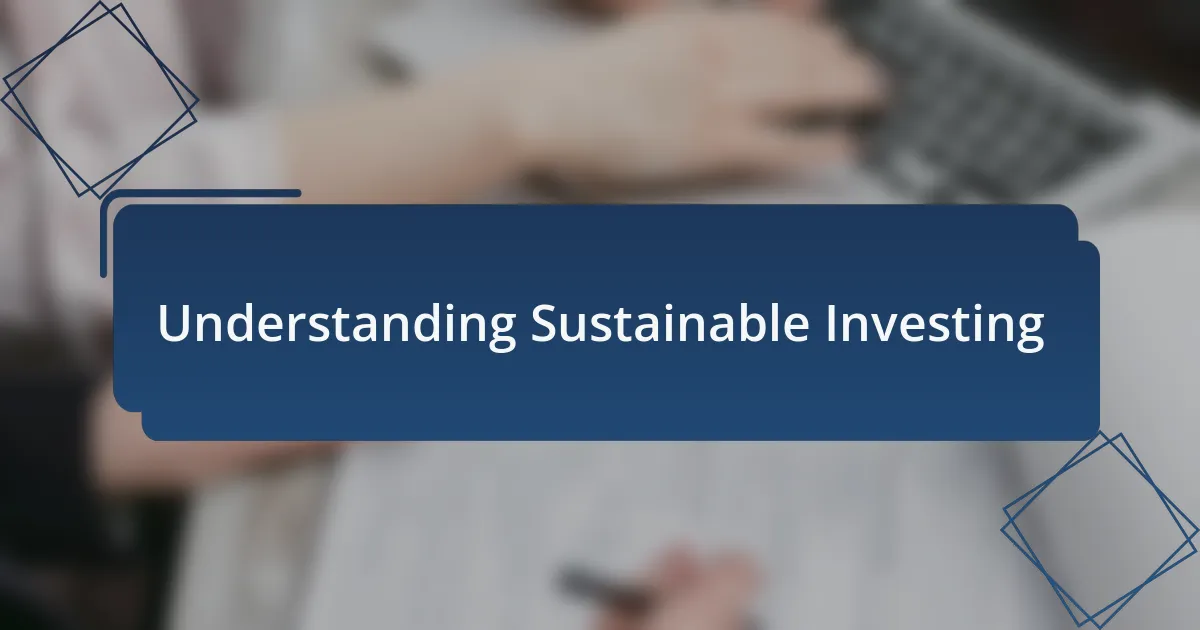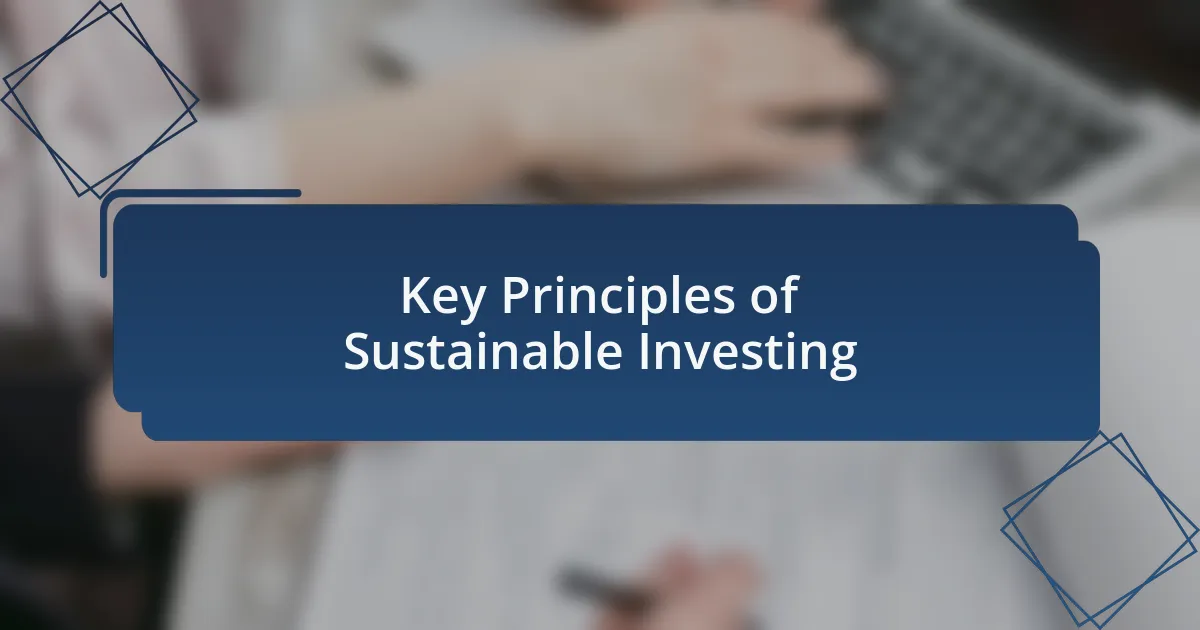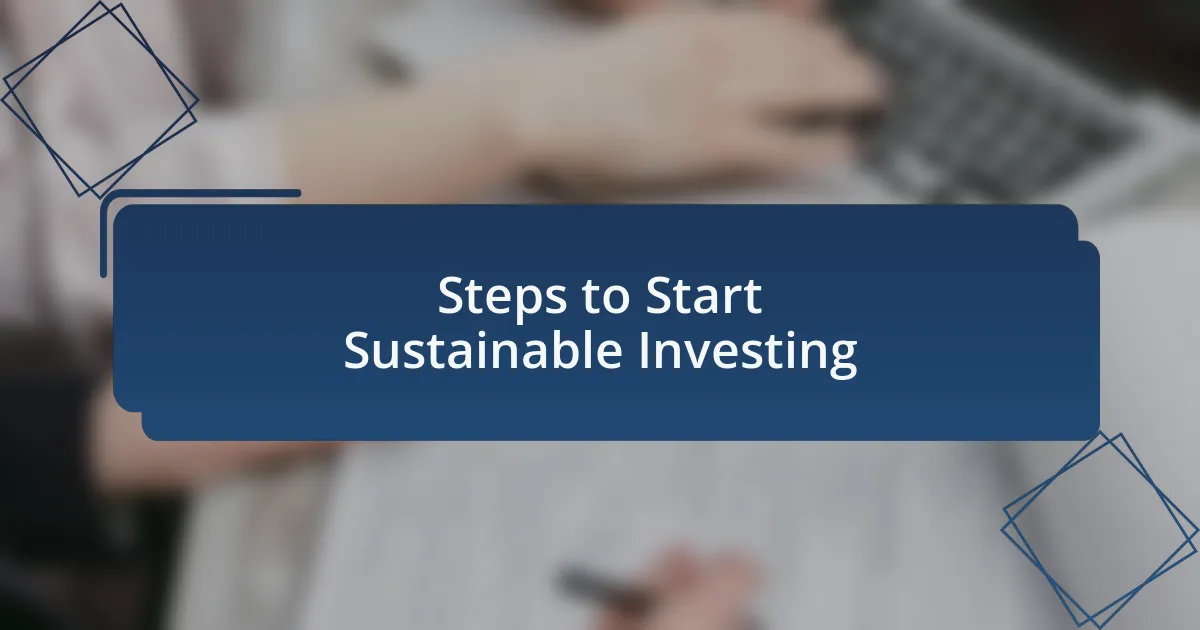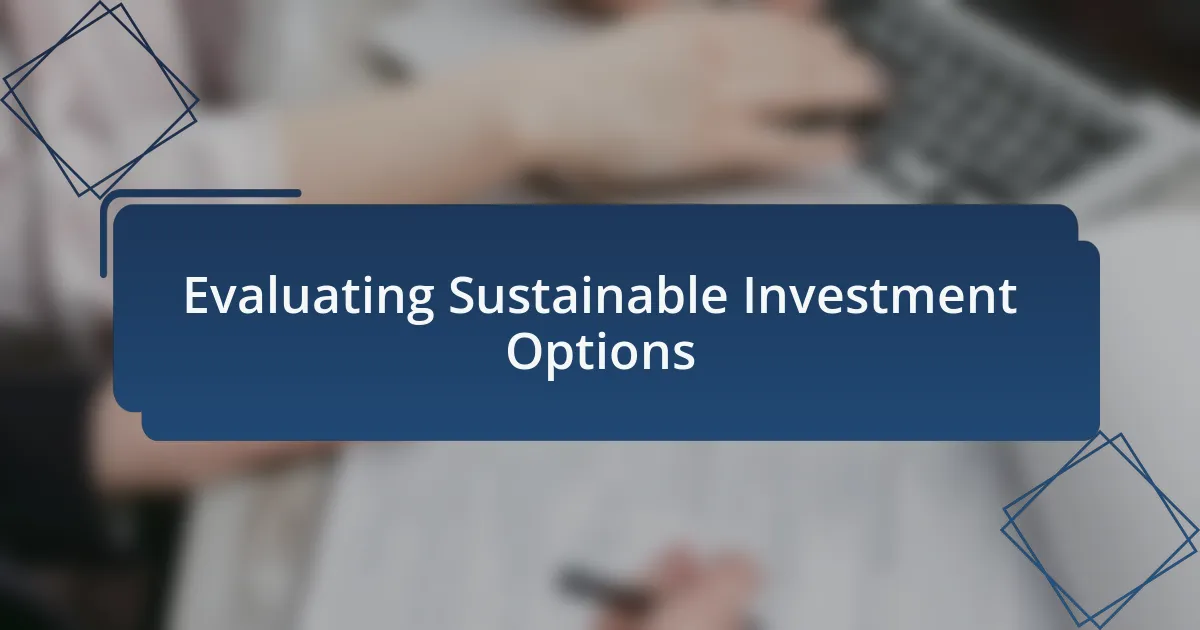Key takeaways:
- Sustainable investing allows individuals to align their financial goals with personal values, contributing positively to society and the environment.
- Key principles of sustainable investing include integrating ESG factors, focusing on long-term impacts, and advocating for transparency and active ownership.
- Evaluating sustainable investments involves examining ESG scores, ensuring company transparency, and diversifying across various sectors to mitigate risks.
- The journey emphasizes patience, community support, and the importance of authenticity in aligning investments with personal principles.

Understanding Sustainable Investing
Sustainable investing is more than just a financial strategy; it’s a commitment to making a positive impact on our planet and society. I still remember the moment I realized that my investments could reflect my values. It was invigorating to think that my portfolio could grow while actively supporting renewable energy projects and socially responsible companies.
Imagine feeling the thrill of knowing that every dollar you invest contributes to something meaningful. When I shifted my investments towards companies with strong environmental practices, it was empowering to see how I could align my financial goals with my desire for a better world. This connection transformed the way I perceived my financial decisions—it became about creating change rather than just chasing numbers.
Sustainable investing also challenges traditional notions of profitability. Have you ever pondered whether you have to sacrifice returns for ethical considerations? My experience showed me that companies prioritizing sustainability often yield impressive financial performance over time. It made me realize that investing with a purpose doesn’t just benefit the planet; it can be incredibly rewarding too.

Importance of Eco-Friendly Finance
The significance of eco-friendly finance lies in its potential to drive systemic change. When I first began to invest sustainably, I felt a blend of excitement and trepidation. Could my choices really influence corporate behavior? What I discovered was eye-opening: as more investors demand transparency and environmental responsibility, companies are forced to adapt, ultimately creating a ripple effect that can reshape entire industries.
Investing with an eco-friendly mindset goes beyond individual gain; it emphasizes collective responsibility. I recall an encounter with a small startup focused on waste reduction that changed my perspective. Supporting such ventures didn’t just feel like an investment in a service, but a leap towards a more sustainable future. Each time I supported these businesses, it felt like I was participating in a movement, not merely a transaction.
Moreover, eco-friendly finance helps mitigate risks associated with climate change. Have you ever considered how environmental issues can impact financial stability? From my experience, companies that disregard sustainability often face significant reputational and financial setbacks. Therefore, aligning investments with eco-friendly initiatives not only demonstrates a commitment to the planet but also serves as a strategic safeguard for long-term stability and growth.

Key Principles of Sustainable Investing
Sustainable investing is grounded in a few key principles, one of which is the integration of environmental, social, and governance (ESG) factors into investment decisions. I remember when I first encountered ESG criteria; it felt like discovering a toolkit that added depth to my investment strategy. By evaluating companies not just on financial performance but on their environmental impact and social responsibility, I felt empowered to support businesses that truly aligned with my values.
Another essential principle is the focus on long-term impact rather than short-term gains. I used to think that rapid profits were the objective, but then I realized that a sustainable investment isn’t just about where the money grows fastest; it’s about ensuring that growth contributes positively to society and the planet. This understanding transformed how I approached my portfolio, shifting my perspective to one that values resilience and lasting change.
Finally, transparency and active ownership play a crucial role in sustainable investing. Engaging with companies I invest in has become a practice dear to me. Whether it’s voting on shareholder resolutions or simply seeking clarity on their sustainability practices, I’ve found that speaking up not only supports corporate accountability but also fosters a deeper connection to my investments. Have you ever had a conversation with a company about their environmental impact? Those interactions can be incredibly revealing and affirm your commitment to sustainability while influencing change from within.

Steps to Start Sustainable Investing
When I decided to start my journey into sustainable investing, the first step was doing my homework. I created a list of companies that resonated with my values, focusing on those actively committing to sustainability and ethical practices. Have you ever taken a moment to really read through a company’s mission statement? It was an eye-opener for me, revealing just how my support could make a difference.
Next, I took the plunge into investment platforms that prioritize sustainable options. Choosing a broker was easier than I thought, thanks to the growing number of platforms specializing in eco-friendly investments. I vividly remember my excitement when I found one that allowed me to filter investments based on ESG scores—just like having a personal eco-conscious investment guide!
Finally, I learned the importance of setting clear goals. What did I want to achieve through my investments? For me, it was about building a portfolio that not only grew financially but also fostered positive environmental change. As I reflected on my goals, I found that having a purpose made the investing process not just about numbers, but about contributing to a future I believe in. How fulfilling would it feel to know your investments are aligned with your core values? For me, it brought a new sense of satisfaction and motivation to my investment journey.

Evaluating Sustainable Investment Options
When evaluating sustainable investment options, I found that examining Environmental, Social, and Governance (ESG) scores became essential. I spent hours researching how companies measured their impact and commitments. Do you ever wonder how companies really stack up when it comes to sustainability? I discovered that digging into these scores helped me see beyond the surface, revealing which companies genuinely aligned with my values.
Another aspect I focused on was the transparency of the organizations I considered investing in. During my search, I reached out to a few companies to ask about their sustainability practices. The responses I received were enlightening—some were eager to share detailed reports, while others barely provided basic information. I realized that transparency is a strong indicator of a company’s commitment to sustainability. Have you had similar experiences when seeking clarity? It reinforced my belief that if a company isn’t open about its practices, it’s a red flag worth noting.
Finally, I embraced the idea of diversification within my sustainable investments. I remember feeling hesitant at first, thinking my portfolio would become too eclectic. However, as I connected with others in the sustainable investing community, I saw how diversifying across industries could mitigate risk while also supporting various sustainable initiatives. Have you ever felt unsure about balancing different sectors? Embracing this approach not only solidified my investments but also deepened my understanding of the broader impact I could have on the environment and society.

Lessons Learned on My Journey
As I navigated my sustainable investing journey, I learned the importance of aligning my investments with my personal values. I’ll never forget the moment I realized that a seemingly great company was involved in questionable practices. That gut feeling pushed me to trust my instincts more fiercely. Have you ever had a moment when a brand you admired turned out to conflict with your principles? It taught me the value of authenticity in my investment choices.
Something else that emerged early on was the significance of community. I participated in local gatherings with like-minded investors, sharing insights and experiences. Listening to others’ stories about their successes and setbacks instilled a sense of camaraderie and support. I vividly remember the encouragement I felt when someone shared how they turned a loss into an opportunity to learn. Do you think surrounding yourself with positive influences can foster growth? I certainly do, as it can open doors to new ideas and strategies.
Throughout this journey, I realized that patience is not just a virtue but a necessity in sustainable investing. Initially, I grew frustrated watching some of my investments lag behind more conventional choices. However, with time, I understood that true sustainable investments often focus on long-term benefits rather than quick wins. How often do we get caught up in immediate results? Embracing a longer view allowed me to appreciate the compounding impact of my choices, reinforcing my commitment to a more sustainable future.